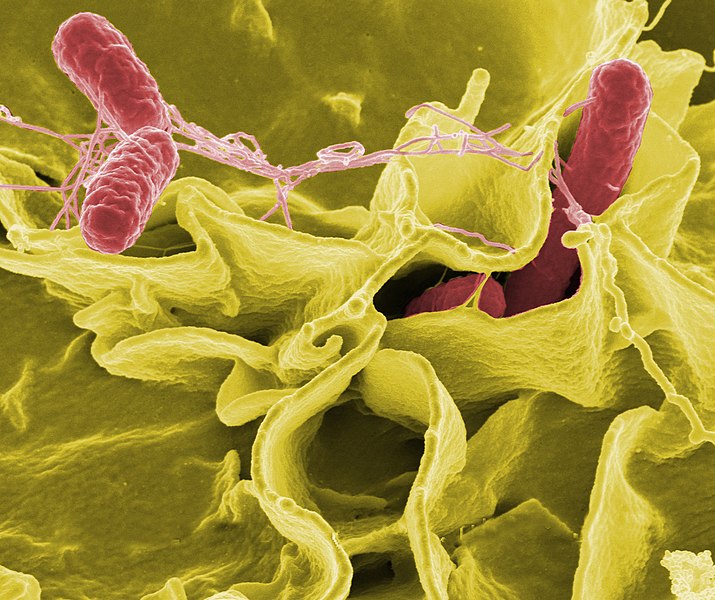 A recent (April, 2011) report that over 200 people contracted Salmonella from captive Dwarf Clawed Frogs (Hymenochirus boettgeri and H. curtipes) has pet owners concerned and seeking advice. The story has also re-ignited discussions about the wisdom of keeping African Clawed Frogs, Xenopus laevis, turtles and other amphibians and reptiles. Unfortunately, not all of the information that has been generated in response to the report is accurate, and much of it only serves to confuse pet-owners.
A recent (April, 2011) report that over 200 people contracted Salmonella from captive Dwarf Clawed Frogs (Hymenochirus boettgeri and H. curtipes) has pet owners concerned and seeking advice. The story has also re-ignited discussions about the wisdom of keeping African Clawed Frogs, Xenopus laevis, turtles and other amphibians and reptiles. Unfortunately, not all of the information that has been generated in response to the report is accurate, and much of it only serves to confuse pet-owners.
Zoonotic Diseases
It is important to understand that any animal, be it insect, fish, frog, dog or bird, has the potential to transfer diseases (known collectively as zoonotic diseases) and parasites to humans. The FDA’s 1975 ban on the sale of turtles below 4 inches in length put a spotlight on reptiles (why they chose 4 inches as a cut-off only served to add to the confusion, incidentally!), but it is a serious mistake to regard them as the only animals capable of making us ill.
One NYC-based infectious disease doctor I spoke with informed me that Mycobacteria infections contracted from tropical fish tanks were responsible for most of his case-load, followed by bacterial infections spread by cats walking on food-preparation counters and cat-scratch complications.
Don’t Kiss the Dog!
I know I run the risk of incurring the wrath of dog owners, but I must say that I have always been shocked by the number of otherwise sensible people (including zookeepers and health professionals), who think nothing of letting their dogs “kiss them” and eat from their plates! This is a very bad idea, as any doctor will tell you. Please remember – Salmonella and other micro-organisms can be spread by any creature.
Contracting Salmonella
Reptiles and amphibians nearly always carry one or another strain of the Enterobacteria Salmonella (over 1,500 species exist, please see photo), and are usually not rendered ill unless other health problems are present. The bacteria are shed in their feces, and transfer to people when swallowed. This usually occurs when people touch their mouths or food after handling a pet and before washing their hands thoroughly.
 Salmonella can survive for quite some time on various surfaces, as evidenced by the many zoo visitors who became ill after leaning on a handrail outside a Komodo Dragon exhibit and then eating (without washing, of course….).
Salmonella can survive for quite some time on various surfaces, as evidenced by the many zoo visitors who became ill after leaning on a handrail outside a Komodo Dragon exhibit and then eating (without washing, of course….).
The Frog-Turtle Connection
That Red-Eared Sliders and Dwarf Clawed Frogs are often associated with Salmonella outbreaks is not surprising…both are bred commercially, often under the crowded, unsanitary conditions that favor bacterial growth and transmission.
In the situation most recently in the news, over 200 people in several states became ill…all had purchased frogs supplied by the same dealer. As is common with pet-contracted Salmonella, 70% of those infected were below the age of 10.
Prevention: Safe Pet Care
Remember, you will not contract Salmonella by merely touching an animal; the bacteria must be transferred to your mouth. Prevention is, or should be, largely a matter of common sense…wash well after handling any animal, supervise children, do not kiss your dog, and so on. Water bowls should be emptied into a toilet or outdoors…never in a sink or tub.
Many people are surprised to learn that iguanas, turtles, dogs and other pets should not be bathed or exercised in bathtubs, especially if infants use the tub as well. Yes, you can disinfect the area (please see article below, and speak with your doctor if such is unavoidable), but you are risking an illness.
Special Concerns
 Healthy adults may contract and rid themselves of Salmonella without incident. However, several groups are particularly at risk for serious or fatal consequences from Salmonella infections and other zoonotic diseases, including, but not limited to, children, immunocompromised individuals, the elderly, people with diabetes and those undergoing chemo-therapy.
Healthy adults may contract and rid themselves of Salmonella without incident. However, several groups are particularly at risk for serious or fatal consequences from Salmonella infections and other zoonotic diseases, including, but not limited to, children, immunocompromised individuals, the elderly, people with diabetes and those undergoing chemo-therapy.
To learn more about precautions to be taken with at-risk people and some easily-overlooked avenues of transmission, please check the recommendations of the Center for Disease Control (linked below).
Further Reading
CDC Guidelines: Reptiles, Amphibians and Salmonella
Disease Concerns for Pet Owners
Aqua Gloves: an important tool in fighting Salmonella and Micobacteria
Distinguishing African Clawed Frogs from Dwarf Clawed Frogs
African Dwarf Frog male image referenced from wikipedia and originally posted by Stuart Halliday
 That Reptile Blog – Reptile, Amphibian and Exotic Pet Care and Information
That Reptile Blog – Reptile, Amphibian and Exotic Pet Care and Information


